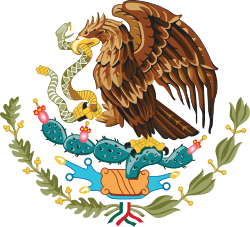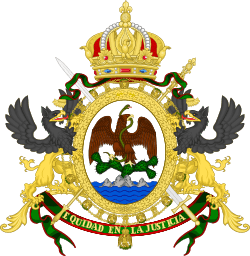Second Mexican Empire
| Mexican Empire | ||||||||||
| Imperio Mexicano | ||||||||||
| Client state of France | ||||||||||
| ||||||||||
| ||||||||||
| Motto Equidad en la Justicia "Equity in Justice" | ||||||||||
| Anthem Himno Nacional Mexicano "Mexican National Anthem" | ||||||||||
.svg.png) Territory of the Second Mexican Empire upon establishment | ||||||||||
| Capital | Mexico City | |||||||||
| Languages | Spanish | |||||||||
| Religion | Roman Catholicism | |||||||||
| Government | Federal constitutional monarchy | |||||||||
| Emperor | ||||||||||
| • | 1864–1867 | Maximilian I | ||||||||
| Regent | ||||||||||
| • | 1863–1864 | Juan Almonte | ||||||||
| Legislature | Congress | |||||||||
| • | Upper house | Senate | ||||||||
| • | Lower house | Chamber of Deputies | ||||||||
| History | ||||||||||
| • | French Intervention | 8 December 1861 | ||||||||
| • | Empire reestabilished | 10 July 1863 | ||||||||
| • | Maximilian I accepts the crown | 10 April 1864 | ||||||||
| • | Emperor executed | 19 June 1867 | ||||||||
| Currency | Peso | |||||||||
| ||||||||||
The Mexican Empire (Spanish: Imperio Mexicano) or Second Mexican Empire (Spanish: Segundo Imperio Mexicano) was the name of Mexico under a limited hereditary monarchy declared by the Assembly of Notables on July 10, 1863, during the Second French intervention in Mexico. It was created with the support of Napoleon III of France, who attempted to establish a monarchist ally in the Americas. A referendum confirmed the coronation of the Austrian Archduke Ferdinand Maximilian, of the House of Habsburg as Emperor Maximilian I of Mexico.
Promoted by the powerful and conservative elite of Mexico's "hacendados", with the support of the French, as well as from the Austrian and Belgian crowns, the intervention attempted to create a monarchical system in Mexico, as it had functioned during the 300 years of the viceroyalty of New Spain and for the short term of the imperial independent reign of Emperor Agustin I of Mexico. Support came mainly from conservative Catholics, which were at the time majority within Mexico, and the main means came from the Mexican nobility, who aimed to promote stability and end the constant cycle of unrest and revolution that had come to a terrible situation with the government of Benito Juárez. The Empire came to an end on June 19, 1867, with the execution of Emperor Maximilian I.
History

The rule of Emperor Maximilian was blemished by constant conflict. On his arrival in 1864 with his wife, Empress Carlota of Mexico, daughter of King Leopold I of the Belgians, he found himself in the middle of a political struggle between the Conservatives that backed him and the opposing Liberals, headed by Benito Juárez. The two factions had set up parallel governments; the Conservatives in Mexico City controlling central Mexico and the Liberals in Veracruz. The Conservatives received funding from Europe, especially from Isabella II of Spain and Napoleon III of France; the Liberals found backing from United States Presidents Abraham Lincoln and Andrew Johnson, after they had finished their own Civil War in 1865.
The United States government viewed Emperor Maximilian as a French puppet, and did not regard his reign as the will of most Mexicans or see him as the legitimate leader of Mexico. They demanded the withdrawal of French forces, and France acceded.[1] In 1867, the empire fell and Maximilian was executed at the orders of Benito Juárez, in the Cerro de las Campanas near Querétaro.
Maximilian proved to be too liberal for the conservatives, and too conservative for the liberals. He regarded Mexico as his destiny and made many contributions. Before his death, Maximilian adopted the grandsons of the first Mexican emperor, Agustín de Iturbide: Agustín de Iturbide y Green and Salvador de Iturbide y Marzán.
Role of France

Part of a series on the |
|---|
| History of Mexico |
 |
|
Spanish rule |
| Timeline |
|
|
Napoleon III had more ambitious goals in mind than merely the recovery of France's debts. Heavily influenced by his wife the Empress Eugenie, he was bent on reviving the Mexican monarchy. Prior to 1861 any interference in the affairs of Mexico by any of the European powers would have been viewed as a challenge to the United States and no one wanted to provoke a conflict with them. However, in 1861 the United States was embroiled in its own bloody conflict, the American Civil War, which made the government in Washington powerless to intervene. Encouraged by the Empress Eugenie, who saw herself as the champion of the Catholic Church in Mexico, Napoleon III took advantage of the situation.
Napoleon III saw the opportunity to make France the great modernizing influence in the Western Hemisphere as well as enabling the country to capture the South American markets. To give him further encouragement, there was his half brother, the duc de Morny, who was the largest single holder of Mexican bonds.
Chronology
- 1832: Archduke Ferdinand Maximilian born on 6 July, the second son of Archduke Franz Karl and his wife Sophie in Schönbrunn Palace, Vienna.
- 1851: Begins career in the Imperial and Royal Navy with the rank of lieutenant.
- 1856: The construction of his castle of Miramar near the Adriatic port of Trieste began.
- 1857: Ferdinand Max appointed the governor-general of the northern Italian provinces of Lombardy-Venetia. On 27 July marries the Princess Charlotte of Belgium in Brussels.
- 1859: On 19 April relieved of his post as governor-general. War breaks out with France and Piedmont-Sardinia.
- 1861: Napoleon III suggests Maximilian as a candidate for the throne of Mexico.
- 1863: In October a Mexican delegation arrives at Miramar to offer Maximilian and Charlotte the crown. Maximilian makes his acceptance conditional on a national plebiscite in his favor.
- 1864: On 14 April Maximilian and Charlotte leave Miramar on board the Austrian ship NOVARA to sail to Mexico.
- 1865: End of the American civil war. Pressure on France to respect the Monroe Doctrine.
- 1865: Maximilian adopts Don Agustin and Don Salvador.
- 1865: Maximilian issues his Black Decree, condemning to death without trial more than eleven thousand Juarez's supporters, thus inflaming the Mexican Resistance.[2][3]
- 1865: Maximilian abolishes on November 30 the Royal and Pontifical University of Mexico[4][5]
- 1866: Napoleon III orders the withdrawal of French troops from Mexico. The Emperor Maximilian refuses to desert his Mexican supporters. Charlotte sails to Europe to plead for help, growing persecution mania robs her of her senses. Republican troops on the advance in Mexico. France and Mexico sign a series of treaties that allow France to seize the receipts of Mexican customs to pay for the French intervention.
- 1867: Maximilian and his Imperial troops besieged in the city of Santiago de Querétaro. The city falls through betrayal after 72 days. On 19 June the Emperor Maximilian and two loyalist generals executed by a republican firing-squad on the Hill of the Bells.
- 1868: On 18 January the body of Maximilian laid to rest among his ancestors in the Imperial Crypt of the Capuchin Church in Vienna.
Territorial division
.svg.png)
The Empire was divided into 50 departments (departamentos):
|
|
|
|
|
Legacy
Today, the Second Mexican Empire is advocated by small far right groups like the Nationalist Front of Mexico, whose followers believe the Empire to have been a legitimate attempt to deliver Mexico from the hegemony of the United States. They are reported to gather every year at Querétaro, the place where Maximilian and his generals were executed.[6]
In popular culture
The 1970 film Two Mules for Sister Sara was set in Mexico during the years of the Second Mexican Empire. The two main characters, played by Clint Eastwood and Shirley MacLaine, aided a Mexican resistance force and ultimately led them to overpower a French garrison.
The 1969 film The Undefeated starring John Wayne and Rock Hudson portrays events during the French Intervention in Mexico and was also loosely based on the escape of Confederate General Sterling Price to Mexico after the American Civil War and his attempt to join with Maximilian's forces.
The 1965 film Major Dundee starring Charlton Heston and Richard Harris featured Union cavalry (supplemented by Galvanized Yankees) crossing into Mexico and fighting French forces towards the end of the American Civil War.
The 1954 film Vera Cruz was also set in Mexico and has an appearance of Maximilian having a target shooting competition with Gary Cooper and Burt Lancaster's character at Chapultepec Castle. Maximilian was played by George Macready, who at 54 was twenty years older than the Emperor was in 1866.
The 1939 film Juarez featured Paul Muni as Benito Juárez, Bette Davis as Empress Carlota, and Brian Aherne as Emperor Maximilian. It was based, in part, on Bertita Harding's novel The Phantom Crown (1937).
In the Southern Victory Series of alternate history novels by Harry Turtledove, Maximilian's Empire survives the turmoil of the 1860s into the 20th century due to the Confederate States of America emerging victorious over the United States of America in the "War of Secession"; thus, the United States becomes too weak and unwilling to pressure Maximilian's puppet state to capitulate to rebels and dissolve. It fights alongside the Confederate States against the United States in 1881-1882, 1914-1917 and 1941-1944.
In Mexican popular culture, there have been soap operas like "El Carruaje" (1967), plays, films, and historical novels such as Fernando del Paso's Noticias del Imperio (1987). Biographies, memoirs, and novels have been published since the 1860s, and among the most recent have been Prince Michael of Greece's The Empress of Farewells, available in various languages.
See also
- First Mexican Empire
- Mexican Imperial Orders
- Imperial Crown of Mexico
- List of Emperors of Mexico
- French intervention in Mexico
- Nationalist Front of Mexico
References
- ↑ President Johnson biography The Miller Center
- ↑ Donald W. Miles (2006), Cinco de Mayo: What is Everybody Celebrating? : the Story Behind Mexico's Battle of Puebla, iUniverse, p. 196, ISBN 9780595392414
- ↑ Jasper Ridley (1993), Maximilian and Juárez, Constable, p. 229, ISBN 9780094720701
- ↑ Catholic Encyclopedia (1911), Catholic Encyclopedia, Volume 10, Appleton, p. 260, ISBN 9780595392414
- ↑ Charles A. Hale (2014), The Transformation of Liberalism in Late Nineteenth-Century Mexico, Princeton University Pres, p. 193, ISBN 9781400863228
- ↑ "Homage to the Martyrs of the Second Mexican Empire".
Bibliography
- Barker, Nancy N. : The Factor of 'Race' in the French Experience in Mexico, 1821-1861", in: HAHR, no. 59:1, pp. 64–80.
- Blumbeg. Arnold: The Diplomacy of the Mexican Empire, 1863-1867. Florida: Krueger, 1987.
- Corti, Egon Caesar: Maximilian and Charlotte of Mexico, translated from the German by Catherine Alison Phillips. 2 Volumes. New York: Knopf, 1928.
- Pani, Erika: "Dreaming of a Mexican Empire: The Political Projects of the 'Imperialist'", in: HAHR, no. 65:1, pp. 19–49.
External links
| Wikimedia Commons has media related to Second Mexican Empire. |
.svg.png)
